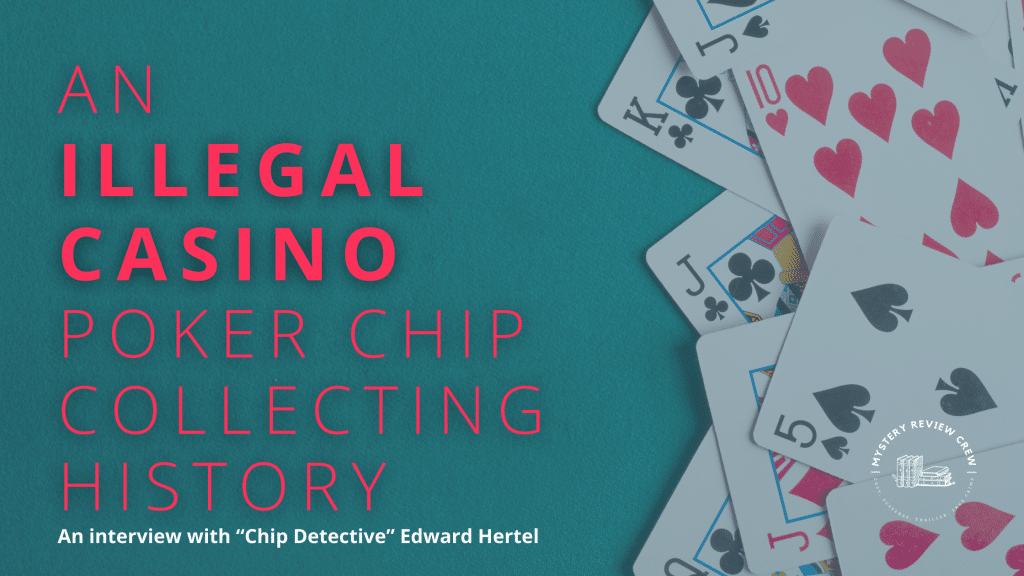We are excited to welcome back Edward Hertel the “Chip Detective” for An Illegal Poker Chip Collecting History! After our three-part series presented by Anita Dickason and Edward Hertel last year, we were excited when Edward Hertel agreed to do an interview so we could learn more about poker chips, what makes them rare chips, and how new collectors can start collecting too!
Avid poker players might be interested to know that in recent years casino chip collectors in the United States, like Edward Hertel, have started publishing the history behind different poker chips both new and obsolete chips in several different publications. This research is a fascinating step back in time to when poker was considered illegal in most states, and not just a popular hobby or career.

So without further ado, here is our interview with Edward Hertel:
A History of Poker Chip Collecting and What Classifies Poker Chips as “Illegal”
- Can you elaborate on what constitutes an “Illegal” club or chip in the context of chip collecting, and how the legal status of gambling in different jurisdictions plays a role in defining this term?
The term “illegal club” or for chips “illegals” is commonly used to describe clubs and chips that were engaged in locations where gambling was not licensed. For most states, it is pretty cut and dry. In most states, historically there has been no legal gambling allowed, so this is easy. If you find a club offering gambling in Texas, it was “illegal”. In other states, such as California, it can be hard to distinguish as some forms of gambling were legal, but others not. At times, with a license, poker was legal in California, but other games not. And then in other states, such as Washington and Oregon, the laws changed back and forth, making it even more complicated as clubs went in and out of legal status.
- What distinguishes a “custom” chip from a “generic” one, and how do these differences impact their use in illegal gambling operations?
“Generic” chips are ones that anyone could go into a novelty shop and buy. They were cheaper and used for small games or when someone needed a bunch of chips. They were commonly used in roulette games as operators would need hundreds of the same chip in many different colors. “Custom” chips were made specifically for one customer and could not be sold anywhere else. These usually consisted of a combination of initials, colors and rim design that was registered to one user.
- Could you tell us more about the characteristics of a “customized” chip, such as inlay/hot stamp color, mold, and inserts, and how these different designs contribute to the uniqueness and security of the chips?
As mentioned, the combination of characteristics of a casino chip is what makes them unique.
The “inlay” or “hot stamp” is the description in the middle of the chip. Usually, there are initials, but sometimes they can be quite elaborate with pictures or unique designs. The more elaborate, the more expensive, so most illegal clubs stuck with the customary three-letter design.
The “mold” is the design around the rim of the chip and there are dozens of different kinds. For the most part, these designs are owned by the chip manufacturer and cannot be duplicated (legally) by any other maker.
Additional security can be added by including “inserts” in the form of different colors of notches along the chip edge. Of course, there would be an upcharge for each additional thing added.
- You mentioned security as a key reason for illegal clubs to use custom chips. Can you elaborate on other motivations behind using custom chips instead of cash in these operations?
For small clubs, cash was commonly used, but it came with a tremendous risk. Since these clubs were illegal, going to the police and asking for help was not an option. This, of course, was common knowledge and these clubs were targeted often in holdups. One deterrent to combat thieves was to have chips in play, and the cash hidden away in safes.
As for security in using “custom” chips as opposed to cheap “generic”, there was always the risk of players “ringing in” their own chips. If the club is using a generic chip, someone could purchase those same chips elsewhere and introduce them into a game. If you have custom chips, assuming you trusted the manufacturer, there is no chance of someone bringing their own chips in.
- Can you provide more insight into why the term “Age of the Illegals” is attributed to the period starting in the 1930s? What factors contributed to the rise of customized casino chips during this time?
The “Age of Illegals” is a term coined by collectors and is more directed to the chips than clubs. Illegal gambling establishments have of course existed forever, and still do today. The Illegals here are the chips that really came about as costs and manufacturing improved in making them. Before the “Age”, custom chips were painstakingly made by hand, one at a time using such materials as ivory and mother-of-pearl. These were expensive (beautiful though) and far out of reach of all but the most plush of casinos.
When production of cheaper clay and plastics become available, manufacturing companies started popping up. This happened around the late 1920s and early 1930s (records mostly exist starting in the 1930s).
The start of the American Prohibition also played a big part in the proliferation of illegal gambling. Since the clubs were already breaking the law with serving booze, they might as well make a little money on gambling too!
- You mentioned varying viewpoints on when the “Age of the Illegals” ended. What factors influenced the end of this era, and how did it impact the landscape of illegal gambling?
Most jurisdictions had times when the law “heated up” and gambling came under fire. This was usually when a politician was trying to make a name for themselves. There is however, usually one time that researchers can point to that was “the end” of open illegal gambling. Sure there would continue to be some gambling, but the feeling that an “era” ended was obvious. For many areas, the late 1940s-1950s were difficult for gamblers. Some point to the post-war attitude of leaning towards family and clean fun. Some say that good old days just ran their course.
Hot Springs, Arkansas, was one of the last holdouts for widespread illegal gambling. They fell on hard times in 1967 when the city clamped down. For me, this was the end of the “Age of Illegals”.
- Considering the changes in the gambling landscape post-1967, what lasting impacts or legacies from the “Age of the Illegals” can still be observed in the world of chip-collecting and gambling history?
The impact of the illegal gambling industry was felt long before the “Age” had ended. Cities like Las Vegas, Atlantic City, Havana, and Cuba, had legal gambling and were run almost exclusively by illegal gambling moguls. Legal gambling today owes everything to these guys who cut their teeth first in illegal establishments in cities such as Kansas City, Detroit, and Miami.
- How has the field of chip collecting evolved over the years, especially in terms of methodologies and the types of chips collectors seek, since the “Age of the Illegals”?
Chip collecting has been a relatively new hobby, especially with old Illegals. Most stories of illegal clubs involve new research, so most are being uncovered for the first time. There is a collector’s club called the Casino Collectibles Association (www.ccgtcc.com) which holds the largest gaming collectibles show in Las Vegas each summer, as well as publishes a quarterly magazine in which I submit a lot of my research to.
- Your dedication to researching casino chips from illegal gambling clubs is evident. What initially sparked your passion for collecting these chips, and how has this interest evolved over the years?
I started my passion by first grabbing a few chips off the tables after my first visit to Las Vegas. I did some research and found the Casino Collectibles Association which linked me to other collectors. One of them told me some stories about illegal gambling down a road in nearby Galveston, Texas, and gave me a couple of chips. From that point on, I was fascinated with the history and never looked back.
- Among the numerous stories and investigations into illegal clubs, is there a particular discovery or investigation that stands out as the most memorable or impactful for you? What made it so significant?
When at a small chip show in Biloxi back in 1999, I by chance was introduced to an oldtimer named John Romeo who used to own a club. His stories were fascinating and the personal touch was so different than the newspapers and dusty books I usually get my information from. Unraveling his story was very personal to me as I know I was able to save history that would otherwise be lost.
Over the years I have been fortunate to meet a few other actual owners of clubs during the “Age”. Unfortunately, all of them have since passed. When working with establishments that operated sometimes 70-90 years ago, finding people who remember them is getting next to impossible. I am fortunate that I got what I did, but if I had it to do over again, I would have made more of an effort to find these people earlier.
- Given your deep dive into Dallas’ history, especially during the prohibition era, do you feel a personal connection to the city’s past? How has exploring its underworld history shaped your understanding of Dallas as a place?
Being from Houston, Texas history has always been something I enjoyed, so when I discovered these interesting pockets of illegal gambling in state, I really pursued it. Benny Binion is a legend in Las Vegas, and most histories of him usually include something brief like “a former Dallas gambler” before going into his history in Vegas. If you like your history in small bite-size pieces, that will do, but what is missed is an absolutely incredible story. In my opinion, much more interesting than his time in Las Vegas.
- Looking ahead, what would you like your legacy to be in the realm of casino chip collecting and documenting the history of illegal gambling clubs? How do you hope your work will influence future enthusiasts and researchers?
I really just like that people enjoy the work and research I do. Most of these stories have never been told and documenting them is a mission I really take seriously. What might seem silly to some, these are people’s lives that are lost to history, waiting to be uncovered. I know I’m not solving any real problems with this research, and being referred to as an “illegal gambling expert” gets some raised eyebrows, but it’s who I am and what I like.
- Collecting and researching casino chips from illegal clubs must come with unique challenges. Can you share some of the most significant challenges you’ve faced in your hobby, as well as the most rewarding aspects that keep you passionate about it?
I have learned some lessons over the years. I always assumed everyone thinks the same as I do when it comes to illegal gambling. I had one woman email me years ago with some chips she found in her grandparents’ house. I did a little digging for her and found out her grandfather was part owner in an illegal casino in Saratoga Springs, New York, alongside a rather famous gangster.
When I communicated this to her, she immediately argued back that “Papa would never be in business with those people!” I was rather insistent to the contrary, going as far as to sending news articles and court documents. She replied how devastated she was, at which point I realized I had made a mistake by pushing the narrative on an unwilling recipient. I should have understood that what was interesting history to me, was family history to her. I realized then and there that I needed to be more delicate.
- For individuals interested in following a similar path of collecting and researching casino chips, especially those from illegal clubs, what advice would you give them? Are there lessons you’ve learned that you wish you knew when you first started?
For those wanting to collect different casino chips from illegal clubs, I would recommend joining the Casino Collectibles Assoc (www.ccgtcc.com) and looking me up ([email protected]). I am always ready to talk chips! The subgroup of collectors specializing in Illegals is smaller than some in areas, but very enthusiastic.
- How did you acquire the new chips?
I’ve been collecting for over 30 years now. I started by buying from dealers at shows and online auctions. These days, there is a group of enthusiasts like myself who just find chips and send them around to their buddies. It gets harder to find new stuff, but when something fun comes around, it’s always a good time!
- Anita mentioned that you have over 10,000 chips in your poker chip collection and that you trace chips back to the real casino that ordered them. That’s how you find the casino. Can you explain the process and your research behind all of that
Of the 10,000 or so chips, maybe 6,000 have been identified as coming from an illegal club. We are lucky that some of the old chip manufacturers had records of who ordered them. On these records will be varying degrees of helpful information. If we are lucky, we can get club names, who ordered the chip, addresses, and when they were ordered. Other records don’t have as much information, but a good researcher can use whatever is available to track down a club.
Unfortunately, there are records which just don’t have enough information, which leads to chips we have to classify as “unknowns”. There are also chip manufacturers which have no records at all, leaving tens of thousands of chips with no hope of finding where they belong.
As for the collector, there is good news though. Over the years, I have done independent research on the records and have found that for every one chip known in the hobby, there are at least eight chips which have never been found (yet). The hunt is on!
Thank you, Edward Hertel, for your dedication to researching and preserving the history behind poker chips and the casinos that housed them. The intrinsic value may not be fully seen yet, but is it very much appreciated. For more information about the history of Illegal Poker Chips (Or to start you own poker chip collecting) please visit: https://www.chipster.net/
About Edward Hertel
Ed Hertel lives in Houston, Texas, and has been collecting both artifacts and history of illegal gambling casinos for more than thirty years. He is a proud member of the Casino Collectibles Association and was honored last year to be inducted into its Hall of Fame for his work in promoting the hobby through education. You can read some of his research on his website (www.chipster.net) which also has contact information.






